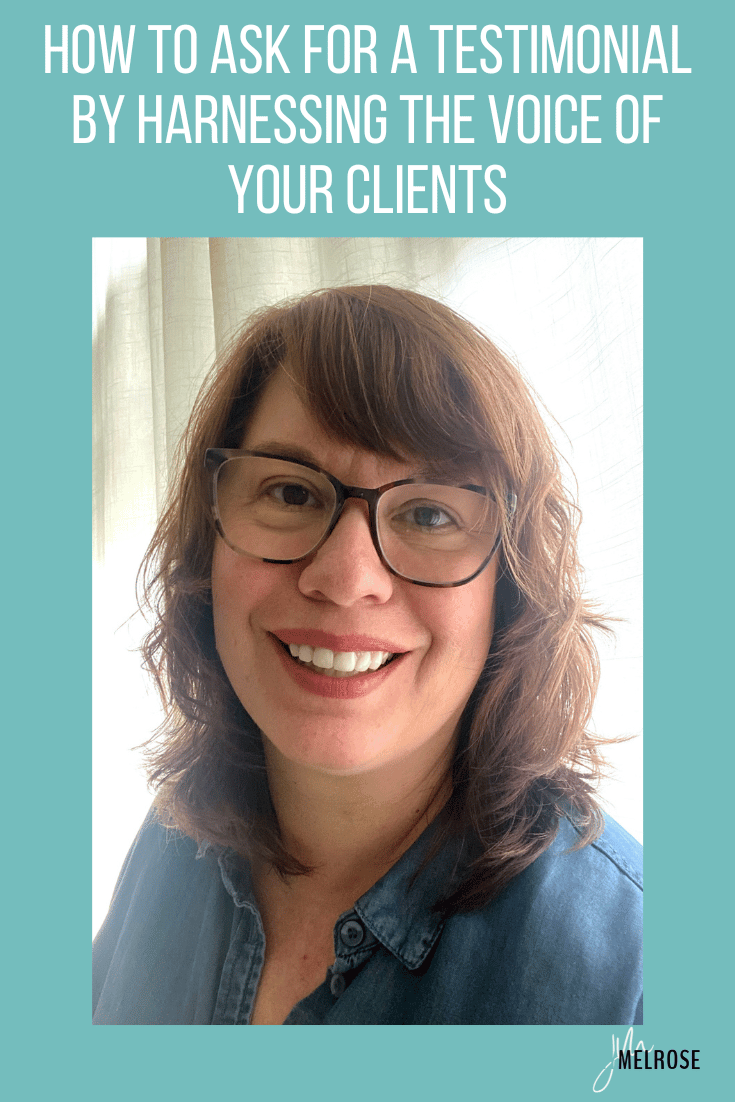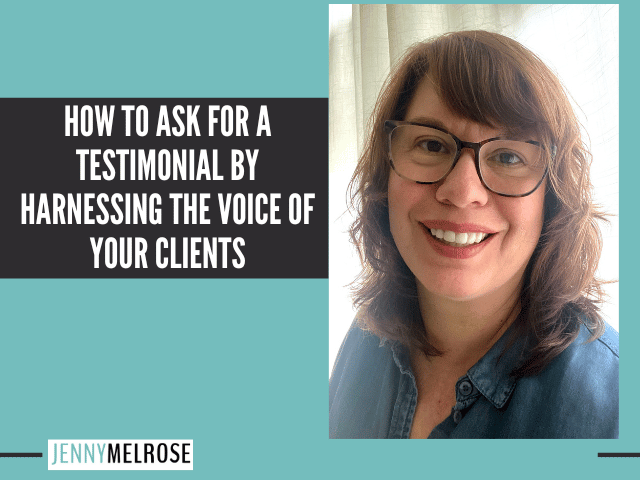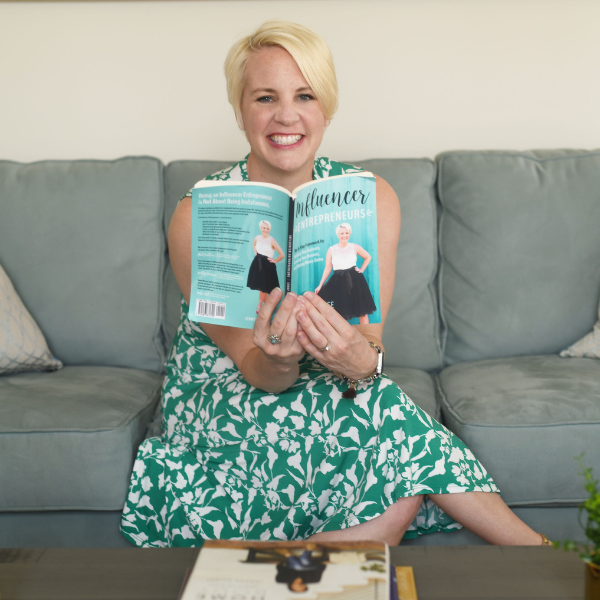Learn proven techniques to effectively ask for testimonials, harnessing the power of client experiences to build trust and credibility.
IE 373: How to Ask for a Testimonial by Harnessing the Voice of Your Clients

Testimonials are powerful to build trust and credibility with potential customers and create compelling narratives that tell a story and capture the emotions of their target audience. On this episode, Lisa Speer teaches businesses how to get those testimonials.
Lisa Speer owns the business Speerhead Solutions.
She focuses on branding that brings out the soul of your business. This is branding that goes beyond surface level and reflects your vision, your values, and your vibe.
She offers a full range of services, from stand-alone brand strategy to brand audits to comprehensive brand packages.
She also works with many new and established small businesses. Her sweet spot is working with professional service businesses, such as coaches, consultants, and creators.
She also works with non-profit organizations and product businesses as well.
When is the right time to ask for a testimonial?
The right time to ask for a testimonial is when emotion and success are at their peak – when you’ve completed a major milestone or project with a client and they are happy! That is when customers are the most willing to say yes.
Positive energy and emotion are at a high point. The results are fresh.
If tangible metrics are important, you may want to follow up a 2nd time at a later date to gather that info. For example, “After working with so and so, our profits increased 15%.”
Get the initial testimonial while the emotions are high and then get the data points later.
It’s possible to get testimonials a month, 6 months, or a year later. It can just be more challenging because you have to refresh people.
Numbers are important in a testimonial because they bring your eyes to the data. You have to back up everything you do with data. It can be more challenging to find data points.
Lisa always listens for clarity and confidence. Clients should feel like they can get out there and market themselves to the world.
In the beginning, there may not be as much data and it may be more challenging. If you are rebranding, you can get data more quickly.
What is going to be the most impressive and impactful? Many times, it is the data.
Perhaps you are creating a recipe or a parenting course. It may be difficult to measure that.
Clarity helps many clients see they are giving their customers back their time and making something easier. That is what they are giving their customers.
Maybe they saved them five hours in the kitchen or years of agony trying to better parent their kids.
Lisa had one client who had been searching for someone like her for two years.
He needed someone to define his niche and make him stand out in the marketplace. He didn’t know how to do it. Time can be a great data point.
Another data point can be money-related. “This is the best money I’ve ever spent.”
While your business may not have increased by a certain percentage or you brought in a certain amount of revenue, there are always things you can find a way to measure.
How do I approach someone for a testimonial?
- Make sure the client is happy.
- Acknowledge what you’ve accomplished together.
- Request a testimonial – Would you be willing to create a testimonial for the work we did together?
Build something into your business processes to get testimonials.
Ask what was most valuable about the process or if anything was missing or incomplete.
This will give you an indication of anything you need to wrap up with them so it doesn’t become a lingering pain point. If you haven’t asked and don’t know that, they might not be 100% happy.
Ask them how they would describe the process to someone else. That will clue you into how they might describe a testimonial.
When you have hit a milestone, acknowledge and celebrate what they have accomplished. They might not be slowing down enough to notice and you can help them point it out and reinforce what you are doing together.
Ask them for a testimonial of the work you have done together. This can be a simple request in person, in the moment, on a video call, or via email.
What should I think about before asking for a testimonial?
Testimonials are gold. But simply asking for one doesn’t ensure it will be strong & effective.
So before approaching someone, it’s important to understand the anatomy of a powerful testimonial.
- The before – their challenges or the situation they were facing before they started working with you.
- The after – the results you provided, how they feel.
- What stood out? – the value, process, approach, etc.
- What it was like working with you? – their experience.
- What would be helpful for someone else to know? – more details.
Be conscious that some people don’t want to talk about the fact that they had a problem. You want to make sure that you can frame the testimony around them having their best foot forward and the challenges before they hired you.
People make emotional buying decisions so you want to get the emotions in also.
The more you can paint a picture of the challenge, the solution, and the emotions people went through, it will connect with your prospects on a deeper level because they can picture themselves in a person’s shoes.
Asking what stood out to them will amplify your approach. You are not telling them what to say but you are helping shape the direction of a testimonial when you understand what you want to highlight.
What value did they get? It might be monetary or time value.
When people talk about what it was like to work with you, it helps paint a picture for someone else to have that experience.
If people might describe the experience differently to someone else, you might get some marketing terms out of it.
Should I provide a template for the testimonial? Or is there a better way to make it easy?
Make it easy for them to say yes. Many people are scared of a blank sheet of paper, so help them by
- Providing tailored questions as prompts from the anatomy of a powerful testimonial. It helps guide them and what you’d like them to be focused on in testimonials.
- Offering to craft the testimonial based on their answers or they can use the prompts to write it themselves.
Giving options allows them to pick what is easiest for them. You don’t have to ask all five things.
The before and after are really important and also getting something about what it was like to work with you. The more you can paint that picture, the more it will help them connect.
If it’s been a while since you worked together, provide a recap of work completed and what you accomplished together to refresh their memory. If you have notes of things they said, you can include that as well.
While you are working with your clients, keep your ear to the ground to listen for potential testimonials. When you put together the things you know they have said, it is less daunting for your clients and reminds them of what you have accomplished.
Sometimes, there is gold in what people say about your services while you are working with them.
Some people are very good at crafting a testimonial and it might be better than you could put together because it is in their voice, language, and emotion. They can choose from the options.
It is never too late to get testimonials and they are the core of your business. It is essential to master this process and it is easy to implement.
You have to train your brain to listen to the things people say and the opportunities to get testimonials. You just need a process to get the testimonials as you are working with clients.
How do I ensure the testimonial is genuine and authentic?
- First, use as much personal info as they are willing to share. Use photos, names, titles, or the business or the industry they work in. This demonstrates they are real people and also helps prospects connect.
- Second, find some way to identify them as relatable, even if they are not willing to give their actual name or business. They can still use their industry or title. They may also use their initials. Some people are not willing to be as vulnerable because they don’t want to admit they need help. Be sensitive to that but find a way to share their story.
- Third, make sure It’s not generic. As much as I love hearing “Lisa’s great and I recommend you hire her,” it doesn’t help anyone who’s reading the testimonial connect emotionally or tell them anything substantial in their selection process.
The more details and more emotion someone is willing to share, the better. This is where the prompts come in handy because they can shape the tone of what you are trying to elicit in someone.
Even with the shortest version of a testimonial, it should say something impactful.
Here’s an example from my business overview one pager where I only had room for one sentence each.
Each of these has a hard-hitting impact with just one sentence alone. It doesn’t paint the before and after in a concrete way but it does demonstrate the value, impact, and effectiveness.
When thinking about which testimonials to place where, think about range. Each one can highlight different facets of what you can provide.
They are not all repetitive and in the same spot on your website. Make sure you get a good mix of types of reviews in various places.
You can also think about this categorically.
For example, for a parenting blog, one testimony might be about potty training. Another might talk about the ways you gave them for effective timeouts.
Varying testimonies take the different aspects of what you are teaching and how they benefited from what you taught in that program. One person might relate to the emotional part of it while another talks about the time aspect.
What is valuable to each person is different based on their own experience. The bigger the range you can show, the more it is likely that the prospect is going to find something that they can connect with.
Is it appropriate to follow up if I don’t receive a response?
Yes! Most of the time when people are happy, they just get busy and forget to respond. They might get your email and be in the middle of something else.
They may be happy to get the reminder. Most people want to help but you have to make it easy for them.
If someone has already said yes, you 100% need to follow up because they already agreed to help you. If someone hasn’t responded yet, try to find a balance between a reminder and being pushy.
You know your clients and the type of people you work with. You probably know their personal situations with illness or children’s schedules.
Be sensitive to that but don’t be afraid to ask. People may want to take a break from their responsibilities and give you a testimonial.
Be authentic to yourself and don’t be afraid to take the step. If you don’t hear something, wait a certain amount of time and follow up again.
People get busy. Inboxes get bombarded. Be aware also of heavier times of email sends, such as black Friday, and avoid those times to ask for a review.
Two other options for getting reviews are:
- LinkedIn: Request a recommendation and include the original testimonial when you request it.
- Google Business Review: Send an email with the original testimonial and link to review your business.
Once they have reviewed you elsewhere, simply ask “Thank you for your review. Would you be willing to share this on LinkedIn or Google also?”
Branding is bigger than a logo. There are even invisible parts to your brand! This checklist reveals the essential items of a fully developed brand. Many of these you may not know about or fully understand the value or impact of.
The more items you complete for your brand, the better positioned you are to market your business effectively. Branding comes before marketing. Even if you have a brand, you may not be using it as powerfully or impactfully as possible.
Download the Brand Essential Checklist to determine what you’ve already done well and what opportunities you’re missing!
ACTION ITEMS
- If you liked this episode of Influencer Entrepreneurs, please subscribe and leave a fabulous review!
- Ready to go deeper into your business? Join the Insiders Group at the special rate for podcast listeners.


